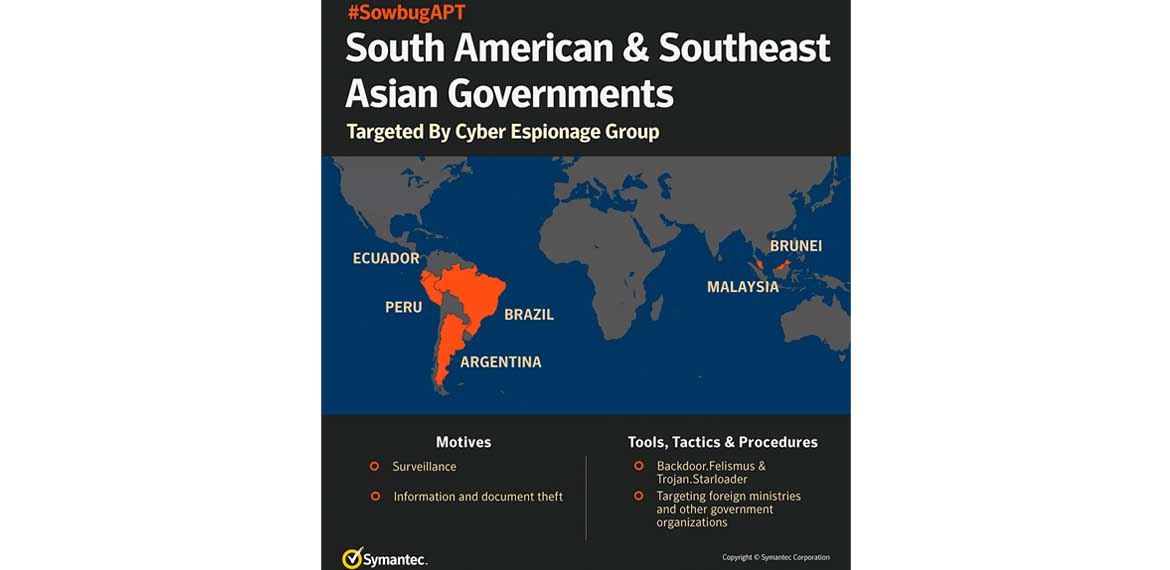Network traversal: Keeping a low profile
Sowbug frequently maintains a long-term presence on the networks of targeted organizations, sometimes remaining inside a victim environment for up to six months. One of the tactics it uses to avoid drawing attention to itself is impersonating commonly used software packages such as Windows or Adobe Reader. It has never attempted to compromise the software itself. Rather, it gives its tools file names similar to those used by the software and places them in directory trees that could be mistaken for those used by the legitimate software. This allows the attackers to hide in plain sight, as their appearance in process listings is unlikely to arouse suspicion.
For example, in September 2016, Sowbug infiltrated an organization in Asia, deploying the Felismus backdoor on one of its computers, Computer A, using the file name adobecms.exe in CSIDL_WINDOWS\debug. From there, it installed additional components and tools to a directory named CSIDL_APPDATA\microsoft\security.
The attackers then began to perform reconnaissance activities on Computer A via cmd.exe, collecting system-related information, such as the OS version, hardware configuration, and network information. They then performed some further reconnaissance, attempting to identify all installed applications on the computer. They returned four days later, creating a sub-directory called “common” in the Adobe directory of the Program Files folder, i.e. c:\Program Files\Adobe\common, and installed another tool in this sub-directory, again named adobecms.exe. This was possibly an updated version of the backdoor.
The attackers’ network reconnaissance appeared to be successful because a second computer of interest in the organization was identified and compromised. The attackers then returned to Computer A, installing another executable called fb.exe. This file appears to be used to copy Felismus across the network to other computers and there is evidence that the attackers used it to attempt to infect at least two more computers.
The attackers took further measures to remain under the radar by carrying out their operations outside of standard office hours. In this case, the attackers maintained a presence on the target’s network for nearly six months between September 2016 and March 2017.
Infection vectors
How Sowbug performs its initial infiltration of a target’s network remains unknown. In some cases, there was no trace of how Felismus made its way onto compromised computers, meaning it was likely deployed from other compromised computers on the network. In other attacks, there was evidence that Felismus was installed using a tool known as Starloader (detected by Symantec as Trojan.Starloader). This is a loader that installs and decrypts data from a file called Stars.jpg. Additionally, Starloader was also observed deploying additional tools used by the attackers, such as credential dumpers and keyloggers.
It is still unknown how Starloader is installed on the compromised computer. One possibility is that the attackers use fake software updates to install files. Symantec has found evidence of Starloader files being named AdobeUpdate.exe, AcrobatUpdate.exe, and INTELUPDATE.EXE among others. These were used to create versions of the Felismus backdoor as well as other tools.
Global threat
While cyber espionage attacks are often seen against targets in the U.S., Europe, and Asia, it is much less common to see South American countries targeted. However, the number of active cyber espionage operations has increased steadily in recent years and the emergence of Sowbug is a reminder that no region is immune to this kind of threat.
Protection
Symantec customers are protected against Sowbug and Symantec has also made efforts to notify identified targets of its operations.
Customers with Intelligence Services or WebFilter-enabled products are protected against activity associated with the Sowbug group. These products include:
• Web Security Service (WSS)
• ProxySG
• Advanced Secure Gateway (ASG)
• Security Analytics
• Content Analysis
• Malware Analysis
• SSL Visibility
• PacketShaper
Symantec has the following specific detections in place for the threats called out in this blog:
AV
• Backdoor.Felismus
• Trojan.Starloader
IPS
• System Infected: Backdoor.Felismus Activity
• System Infected: Backdoor.Felismus Activity 2
• System Infected: Backdoor.Felismus Activity 3
Indicators of compromise
Backdoor.Felismus samples
| MD5 | Detection |
| 514f85ebb05cad9e004eee89dde2ed07 | Backdoor.Felismus |
| 00d356a7cf9f67dd5bb8b2a88e289bc8 | Backdoor.Felismus |
| c1f65ddabcc1f23d9ba1600789eb581b | Backdoor.Felismus |
| 967d60c417d70a02030938a2ee8a0b74 | Backdoor.Felismus |
Trojan.Starloader samples
| MD5 | Detection |
| 4984e9e1a5d595c079cc490a22d67490 | Trojan.Starloader |
Hacktools
| MD5 | Detection |
| e4e1c98feac9356dbfcac1d8c362ab22 | Hacktool.Mimikatz |
Installation directory
• %WINDOWS%\debug
• %APPDATA%\microsoft\security
Command and control infrastructure
• nasomember[DOT]com
• cosecman[DOT]com
• unifoxs[DOT]com











